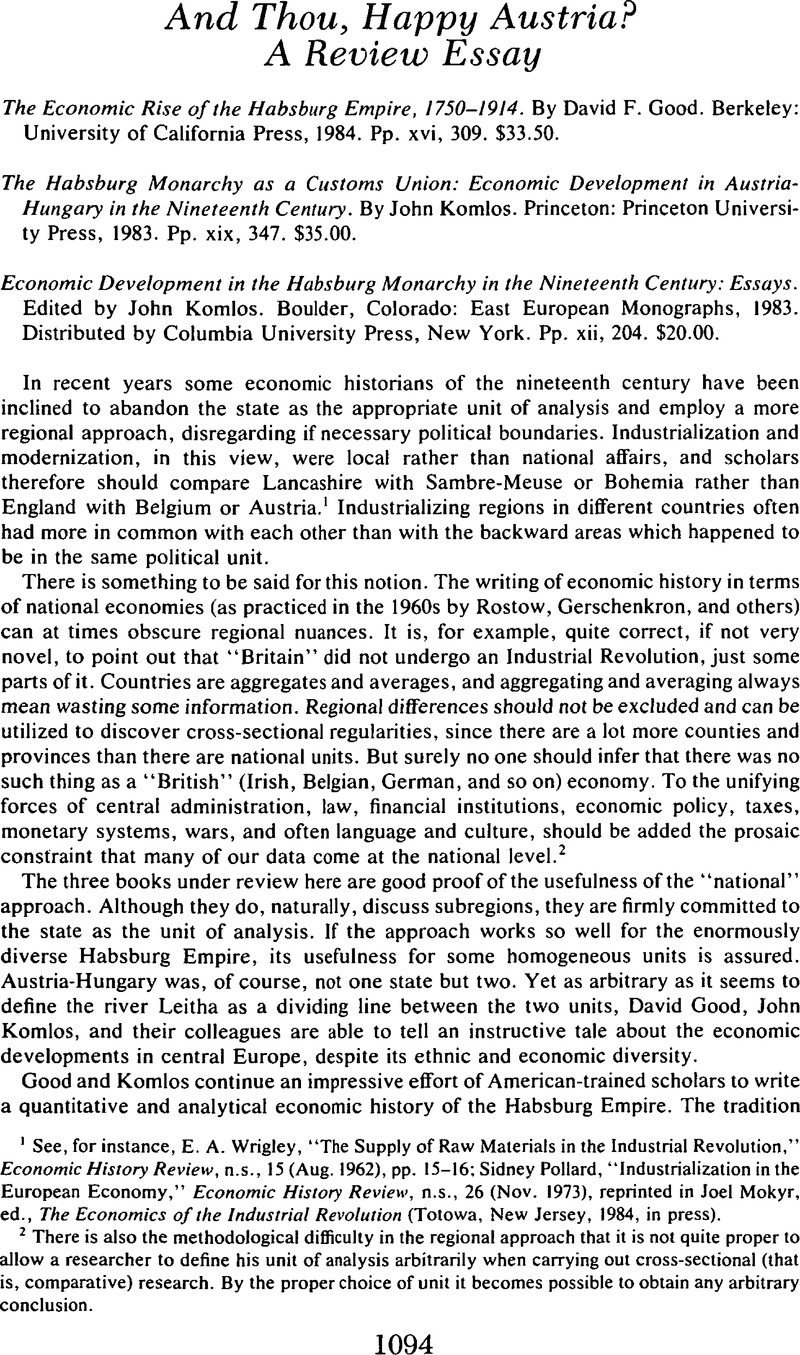Article contents
And Thou, Happy Austria? A Review Essay
Published online by Cambridge University Press: 03 March 2009
Abstract

- Type
- Review Articles
- Information
- Copyright
- Copyright © The Economic History Association 1984
References
1 See, for instance, Wrigley, E. A., “The Supply of Raw Materials in the Industrial Revolution,” Economic History Review, n.s., 15 (08. 1962), pp. 15–16;CrossRefGoogle ScholarPollard, Sidney, “Industrialization in the European Economy,” Economic History Review, n.s., 26 (11. 1973),CrossRefGoogle Scholar reprinted in Mokyr, Joel, ed., The Economics of the Industrial Revolution (Totowa, New Jersey, 1984, in press).Google Scholar
2 There is also the methodological difficulty in the regional approach that it is not quite proper to allow a researcher to define his unit of analysis arbitrarily when carrying out cross-sectional (that is, comparative) research. By the proper choice of Unit it becomes possible to obtain any arbitrary conclusion.Google Scholar
3 The best work on the Industrial Revolution in the Czech lands is by Amost Klima, one of whose papers is reprinted in the volume edited by Komlos (with the footnotes, for some reason, omitted). So far no cliometric attempt to explain the sources of the Czech success has been attempted.Google Scholar
4 Total grain production between 1781 and 1841 according to Komlos increased at 1.4 percent per annum or 0.9 percent per capita, far better than in the Austrian part of the Empire. Even more amazing is the finding that this expansion occurred at a more or less constant acreage and without any evidence for mechanization. In England and France average wheat yields between 1815 and 1850 on “prime quality lands” grew at an annual rate of 0.59 percent and 0.74 percent respectively. Even Newell's optimistic assessment of agricultural productivity growth in France after 1815 is only 1.1 percent per annum. Compare O'Brien, P. and Keyder, C., Economic Growth in Britain and France, 1780–1914 (London, 1978), p. 126.Google ScholarNewell, William H., “The Agricultural Revolution in Nineteenth Century France,” this JOURNAL, 33 (12. 1973), 710.Google Scholar
5 A few examples: in 1901/05 the mean infant mortality in Austria was 212.5 per thousand and in Hungary 211.8 per thousand. This compares with 167 in Italy, 148 in Belgium, and 99 in Ireland. Total iron consumption per capita in 1903/07 in Austria-Hungary was a sixth of Germany's, a third of Sweden's, and three-eighths of France's. The percentage of the labor force in agriculture in 1910 in Austria was 53.1 percent, in Hungary 66 percent, whereas in Germany it was 35 percent and in France 41 percent.Google Scholar
6 Gerschenkron, Alexander, An Economic Spurt that Failed (Princeton, 1977), pp. 50–54.Google Scholar
7 Formally, at least, Gerschenkron is correct in that industrial output in Germany between 1895 and 1913 grew at a considerably faster rate (3.9 percent per annum) than in Austria (2.3 percent) or even Hungary (about 3.1 percent). Good may point out that it is ironic that Gerschenkron has claimed a “failed spurt” for the years of the prime ministership of Ernst Von Koerber (1900–1904). After all, if we follow Komlos's periodization, this was the decade of the fastest industrial growth of Austria (3.7 percent per annum, Komlos, p. 146). At the same time, the Koerber years themselves show a far slower growth rate (1.3 percent).Google Scholar
8 Although on the margin, capital outflows probably contributed to the slowdown of Austria's industrialization, Komlos rather overstates his case. According to his estimates, about 2 billion crowns were invested by Austrians in Hungarian securities between 1873 and 1896 (pp. 187–88), or about 84 million crowns per annum. Austrian GNP in 1911/13 was 16.3 billion crowns (Good, p. 275), which, if extrapolated backwards using Komlos's (p. 249) growth rates yields a nominal GNP of about 6.4 million crowns in 1884, the midpoint of the period under discussion. Total annual outflow was thus about 1.3 percent of Austrian GNP. Komlos assumes that in the absence of lending to Hungary most of this sum would have been invested in Austrian manufacturing, that little of the outflow was compensated by inflows from other sources, and that capital markets were indeed the chief source of financing industrial capital formation. This kind of cliometnc acrobatics leads him to conclude that the great slowdown in Austrian industrial growth was caused by capital market “biases” which drained the funds away to Hungary.Google Scholar
9 See Edelstein, Michael, Overseas Investment in the Age of High Imperialism (New York, 1982), and references cited there.Google Scholar
10 The dismissal of Gerschenkron's work on Austria, for example, is regrettable because he is one of the few historians who tried to establish an explicit link between politics and economic development. It would have been useful if excerpts of this masterful, if peculiar, little book would have been included in the Komlos volume.Google Scholar
11 Gross, Nachum, “The Industrial Revolution in the Habsburg Monarchy,” in Cipolla, C. M., ed., The Fontana Economic History of Europe, vol. 4, part I, pp. 228–37.Google Scholar
12 This is particularly true of Appendix C to Komlos's book in which he tries to demonstrate the errors of everyone who worked on these issues before him.Google Scholar
- 2
- Cited by




